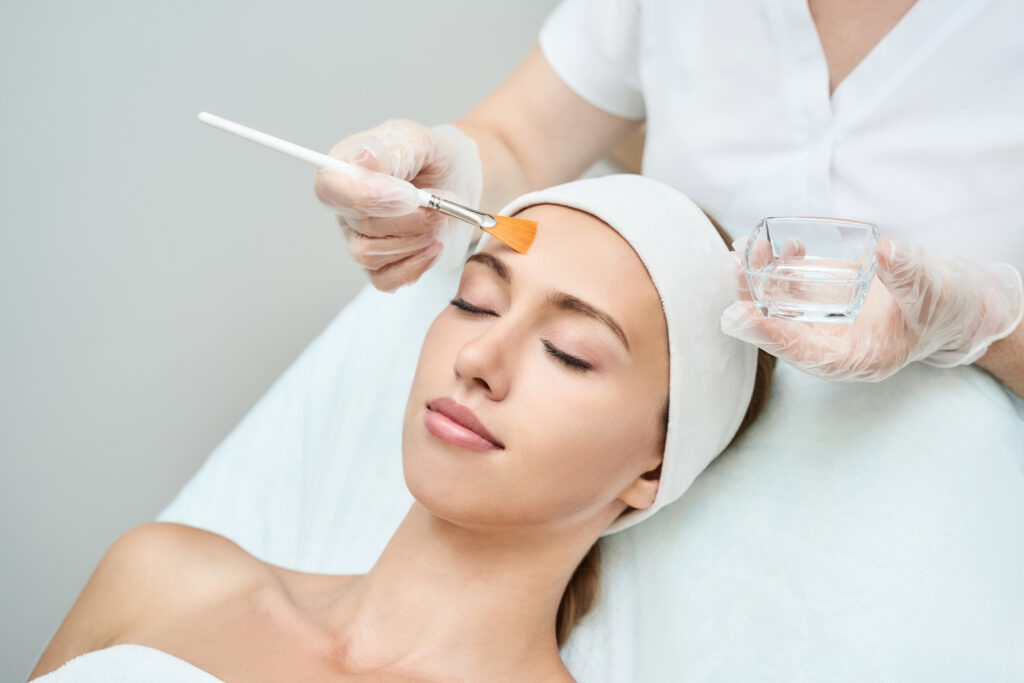

In recent years, chemical peels have become one of the most ideal non-invasive treatments for skin rejuvenating. With their chance to target a wide range of skin concerns, chemical peels offer a versatile solution for individuals looking to improve their complexion and enhance their skin’s texture.
By gently exfoliating the skin with a carefully chosen acid solution, chemical peels help reveal smoother, clearer, and healthier skin underneath. But what exactly can a chemical peel do for your skin? Let’s dive into the specific skin concerns that can be effectively treated with this transformative treatment.
Chemical peels are designed to exfoliate the top layers of your skin, allowing newer and healthier skin to emerge. The process involves applying a chemical solution, typically containing alpha-hydroxy acids (AHAs), beta-hydroxy acids (BHAs), or other compounds, which work to dissolve the outer layer of dead skin cells.
This exfoliation process encourages skin regeneration, resulting in a smoother, more youthful appearance.
Not all chemical peels are created equal. There are main types: superficial, medium, and deep peels, each varying in intensity.
Now that we understand how chemical peels work let’s explore the skin concerns they can effectively address.
Fine lines and wrinkles are often one of the earliest signs of aging, caused by a natural reduction in collagen production. A chemical peel can lessen the looks of these lines by promoting collagen renewal and sloughing away the outer layer of skin, often where the most visible signs of aging reside.
While chemical peels are most ideal at reducing fine lines, medium or deep peels can also improve deeper wrinkles, especially when combined with other treatments.
Sun exposure over time leads to sunspots, freckles, and uneven skin tone. Chemical peels can lighten these areas of discoloration by exfoliating the damaged skin layers, allowing new, healthier skin to emerge.
Hyperpigmentation, which includes conditions like melasma or post-inflammatory dark spots, occurs when excess melanin is produced in certain areas of the skin. Chemical peels can target these areas, fading dark patches by removing layers of hyperpigmented skin cells. With repeated treatments, chemical peels can significantly lessen the dark spots and even your skin tone.
If you’re struggling with persistent acne or dealing with the aftermath in the form of scars, a chemical peel might be an effective solution. Chemical peels, particularly those containing salicylic acid (BHA), can unclog pores, reduce inflammation, and help prevent future breakouts.
For those with mild to moderate acne scarring, chemical peels can reduce the appearance of scars by promoting collagen production and resurfacing the skin. However, for deeper, more severe scars, a combination of approach such as microneedling or laser therapy, may be recommended for optimal results.
Enlarged pores and uneven skin texture can make your skin appear rough or bumpy. Chemical peels, especially superficial ones, can help minimize the appearance of pores and create a more refined, even texture.
Chemical peels help unclog and tighten pores by eliminating the outer layer of dead skin cells. Over time, repeated peels can reduce the appearance of large pores and leave your skin smoother and more even.
Rosacea is a chronic skin condition that causes visible blood vessels, primarily on the face. While chemical peels can benefit some individuals with rosacea, they must be used cautiously. Mild, superficial peels may help reduce redness and smooth the skin’s texture. Still, it’s essential to consult a skin professional to identify if this treatment is appropriate for your skin type.
Even if you don’t have specific skin concerns like acne scars or wrinkles, chemical peels can offer overall skin rejuvenation. A series of chemical peels can leave your skin brighter, more youthful, and refreshed, making them an excellent choice for those who simply want to maintain healthy, glowing skin.
For general skin rejuvenation, superficial chemical peels can work for every 4 to 6 weeks, depending on your skin type and concerns. This routine can help maintain a radiant complexion while preventing signs of aging.
Choosing the correct chemical peel for your skin depends on your specific concerns, skin type, and the desired results. During your consultation, a skincare professional will assess your skin and recommend the appropriate type and strength of peel. Whether you’re targeting acne scars or aiming for general skin brightening, there’s a chemical peel that can address your needs.
The process of getting a chemical peel is relatively straightforward, but it’s essential to know what to expect. During the treatment, you may feel a mild tingling or stinging sensation, depending on the strength of the peel. After the procedure, your skin may peel or flake for a few days as the outer layer sheds.
Recovery time varies depending on the depth of the peel. Subtle peels require minimal downtime, while deeper peels may require up to two weeks for full recovery.
Chemical peels offer an effective and customizable solution for various skin concerns, from fine lines and sun damage to acne and hyperpigmentation. Whether targeting specific issues or simply maintaining a youthful glow, chemical peels provide a non-invasive way to rejuvenate your skin.
Book your chemical peel consultation today if you’re ready to take the next step toward healthier, brighter skin. Let our skincare experts guide you toward a more radiant complexion. We also have a self-assesment test for your reference.
Recent Post